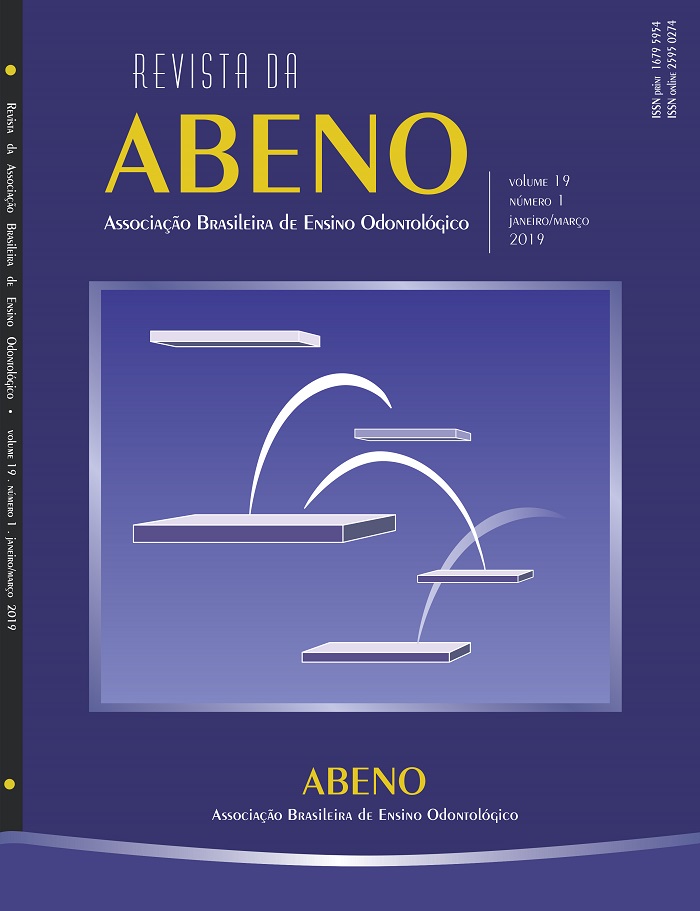Prática preventiva e seu papel educacional junto a uma comunidade acadêmica de Odontologia
DOI:
https://doi.org/10.30979/rev.abeno.v19i1.838Palavras-chave:
Estudantes. Imunização. Hepatite B. Tétano.Resumo
O estudo objetivou verificar a adesão dos estudantes de graduação em Odontologia à campanha de vacinação contra hepatite B e tétano em uma escola particular de Odontologia. A hipótese testada foi que a campanha de vacinação seria um programa efetivo na prevenção da infecção pelo HBV e tétano. O cartão de vacinação e o exame anti-HBs foram analisados como desfecho principal. Os dados foram submetidos à regressão de Poisson bivariada e multivariada (a<0, 5). Idade, ano de admissão, turno de estudos, número de doses de vacinas para hepatite B e vacinação para tétano foram variáveis independentes. Dos 485 estudantes, 318 entregaram a cópia do cartão de vacinação e 295 apresentaram o exame anti-HBs. A mediana de idade dos estudantes foi de 21 anos (76,1% do sexo feminino, 23,9% do sexo masculino). Nos modelos de regressão de Poisson univariada e multivariada, a não vacinação contra o tétano foi considerada fator de risco. Os alunos de graduação matriculados nos anos iniciais foram mais propensos a não receberem a vacinação do que aqueles dos anos finais (p≤0,001). Do total de alunos (318) que entregaram a documentação para hepatite B, 86,1% completaram o protocolo de vacinação (3 doses), enquanto 13,9% o protocolo incompleto (1 ou 2 doses). Os estudantes mais velhos foram mais propensos a não terem tomado as vacinas em comparação com mais jovens (p≤0,001). Em relação ao anti-HBs, 73,9% apresentaram título de proteção positivo. As campanhas de vacinação para estudantes de graduação podem ser efetivas se a adesão dos indivíduos ao calendário vacinal puder ser assegurada. Estratégias para maior adesão dos estudantes, como essa campanha, devem ser pensadas e planejadas pelos cursos de Odontologia.Downloads
Referências
Weber DJ, Rutala WA, Schaffner W. Lessons learned: protection of healthcare workers from infectious disease risks. Crit Care Med. 2010; 38 (8 Suppl):S306-14.
Mahesh R, Arthi C, Victor S, Ashokkumar S. Hepatitis B infection awareness among Dental graduate students: A cross sectional study. Int Sch Res Notices. 2014; 29: 389274.
Brasil, Ministério da Educação Conselho Nacional de Educação. Diretrizes Curriculares Nacionais dos Cursos de Graduação em Odontologia. [Cited Feb. 20, 2019]. Available at: http://portal.mec.gov. br/cne/arquivos/pdf/CES032002.pdf.
Liang TJ. Hepatitis B: the virus and disease. Hepatology. 2009;49:S13–S21.
Kolawole OM, Wahab AA, Adekanle DA, Sibanda T, Okoh AI. Seroprevalence of hepatitis B surface antigenemia and its effects on hematological parameters in pregnant women in Osogbo, Nigeria. Virol J. 2012;9:317.
Lamster IB, Ahlo JK. Analysis of gingival crevicular fluid as applied to the diagnosis of oral and systemic diseases. Ann N Y Acad Sci. 2007 1098:216-29.
Maynard JE, Kane MA, Hadler SC. The global control of hepatitis B through vaccination. The role of hepatitis B vaccine in the Expanded Programme on Immunization (EPI); 1986. 19 p.
Chaves SS, Fischer G, Groeger J, Patel PR, Thompson ND, Teshale EH, et al. Persis-tence of long-term immunity to hepatitis B among adolescents immunized at birth. Vaccine. 2012; 30:1644-9.
Lasemi E, Haddadpour N, Navi F, Rakhshan A, Rakhshan V. Rate of acquired immunity in Dental students after Hepatitis B vaccination. Dent Res J (Isfahan). 2011;8(3):128-31.
Sacchetto MS, Barros SS, Araripe TA, Silva AM, Faustino SK, da Silva JM. Hepatitis B: knowledge, vaccine situation and serocon-version of Dentistry students of a public university. Hepat Mon. 2013 Oct 5;13(10) :e13670.
Al-Maweri SA, Tarakji B, Shugaa-Addi B, Al-Shamiri HM, Alaizari NA, Masri OA. Infection control: knowledge and compliance among Saudi undergraduate dental students. GMS Hyg Infect Control 2015; 1:10
Sernia S, Ortis M, Antoniozzi T, Maffongelli E, La Torre G. Levels of Anti-HBs antibody in HBV-vaccinated students enrolled in the Faculty of Medicine, Dentistry and Health Professions of a large Italian University. Biomed Res Int. 2015; 2015:712020.
Bagheri-Jamebozorgi JM, Keshavarz J, Nemati M, Mohammadi HS, Rezayati MT, Nejad M, et al. The persistence of anti-HBs antibody and anamnestic response 20 years after primary vaccination with recombinant hepatitis B vaccine at infancy. Hum Vaccin Immunother. 2014; 10:3731-36.
Honorati MC, Palareti A, Dolzani P, Busachi CA Rizzoli R, Facchini A. A mathematical model predicting anti-hepatitis B virus surface antigen (HBs) decay after vaccination against hepatitis B. Clin Exp Immunol. 1999 Apr;116(1):121-6.
Leuridan E. Van Damme P. Hepatitis B and the need for a booster dose. Clin Infect Dis. 2011 Jul 1;53(1):68-75.
Singh A, Purohit BM, Bhambal A, Saxena S, Gupta A. Knowledge, attitudes, and practice regarding infection control measures among dental students in Central India. J Dent Educ. 2011 Mar;75(3):421-7.
Petti S, Messano GA, Polimeni A. Dentist’s awarenss toward vaccine preventable diseases. Vaccine. 2011 Oct 19;29(45):8108-12.
Brasil. Ministério da Saúde. Secretaria de Vigilância em Saúde. Departamento de Vigilância das Doenças Transmissíveis. Manual de Normas e Procedimentos para Vacinação / Ministério da Saúde, Secretaria de Vigilância em Saúde, Departamento de Vigilância das Doenças Transmissíveis. – Brasília : Ministério da Saúde, 2014. 176 p. : il.
Downloads
Publicado
Como Citar
Edição
Seção
Licença
Autores que publicam nesta revista concordam com os seguintes termos:
a) Autores mantém os direitos autorais e concedem à revista o direito de primeira publicação, com o trabalho simultaneamente licenciado sob a Licença Creative Commons Attribution que permite o compartilhamento do trabalho com reconhecimento da autoria e publicação inicial nesta revista.
b) Autores têm autorização para assumir contratos adicionais separadamente, para distribuição não-exclusiva da versão do trabalho publicada nesta revista (ex.: publicar em repositório institucional ou como capítulo de livro), com reconhecimento de autoria e publicação inicial nesta revista.
c) Autores têm permissão e são estimulados a publicar e distribuir seu trabalho online (ex.: em repositórios institucionais ou na sua página pessoal) a qualquer ponto antes ou durante o processo editorial, já que isso pode gerar alterações produtivas, bem como aumentar o impacto e a citação do trabalho publicado (Veja O Efeito do Acesso Livre).






